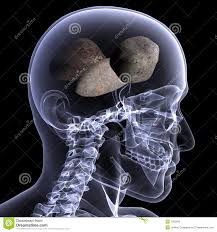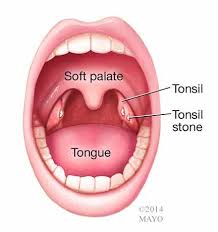
One out of every four or five people DO have rocks in their head. Well, more accurately, in their throats. If you still have your tonsils, there are nooks and crannies around them called tonsillar crypts that can harbor small tonsillar stones called tonsilloliths. These small stones, ranging from the size of a grain of rice and up to that of a pea, can be the source of several problems that may be eluding either a diagnosis or an explanation for many of us.
Although they are not outright medically dangerous, these tonsillar stones can have several undesirable side effects. The most common is the presence of bad breath that can be hard to eliminate. If most everything else you have tried for your breath has had limited benefit, it may be the anaerobic bacteria around the stones that is the culprit. They form a sulfurous waste that can be the source of particularly bad breath. Tonsilloliths can also cause sore throat, ear pain or pain with swallowing. And the inflammation they can cause may be a root factor in recurrent throat infections, although 90% of sore throats in adults are caused by viruses, not streptococcal bacteria.
So where do they come from? Food debris or mucous from post nasal drip can lodge in those tonsillar crevices, which may be more prominent in large or recurrently inflamed tonsils. There they can combine with white blood cells that are trying to clean up local inflammation. The remains of this process can harden into stone like structures. Sometimes you can actually see these if you take a close look around the tonsils with a flashlight (those of us over 50 may also need our readers on to see the details).

If you have tonsillar stones, you may be able to clear most of them on your own. Start with something gentle, like gargling with a salt water or water/peroxide rinse. Try this at night for several days in a row. Sometimes impacted stones may respond to a direct stream of irrigation from a water pik type device. At times the gentle oblique pressure of a Q-tip may dislodge a stone. Although online discussion sites advocate tools like toothpicks, bobby pins, chopsticks or straws, these should generally be avoided, as they can cause tissue damage or infection. I once saw an ER patient who had swallowed a toothpick while ‘trying to clean her tonsils’. It took an endoscopy to get it out. Larger stones or more difficult cases may need laser treatment with an ENT specialist.
On the front end, preventing the formation of tonsil stones can be as simple as good dental hygiene. Brushing the teeth and tongue after meals, at bedtime and first thing in the morning, along with flossing daily will reduce food debris and also clean out bacteria. Your hygienist will approve, your breath may improve, and you may end up with a few less rocks in your head!

